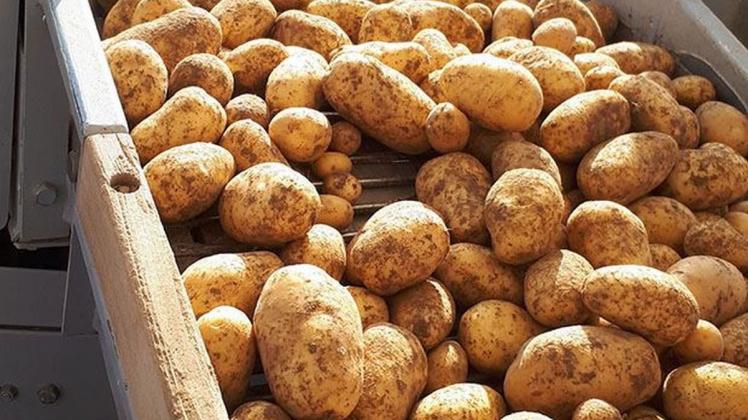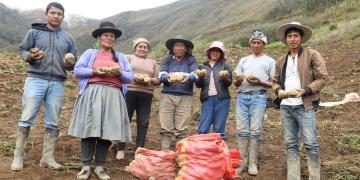EEUU: As Covid-19 threatens global food security, fresh potatoes are back on the tables
COVID-19 is driving demand for fresh potatoes in supermarkets and grocery stores across the globe as people stock up on inexpensive food.

Fresh potato has become a favorite during the lockdown, along with rice, wheat flour, bread and pasta. In the West, where processed products constitute the bulk of potato consumption, demand for fresh potatoes has skyrocketed. The lockdown has also increased demand for fresh potatoes in the developing world. Even in the traditionally non-potato-consuming southern states of India, potato has become popular, in part due to its long shelf life vis-à-vis other vegetables.
It is not surprising to see the importance of potato rise during this pandemic. It is, after all, the third most important food crop behind rice and wheat and a staple for 1.3 billion people across the globe, including millions of poor in eastern India, Bangladesh and the mountainous regions of China. Despite its significance as a staple for so many poor, it is rarely mentioned in the same breath as rice and wheat when assessing food security. In the past few weeks, there has been a lot of reporting and analysis of rice and wheat as the COVID-19 pandemic confined more than half of the planet (approximately 4 billion people) to their homes and shut down a major part of the global economy. But not much attention has been devoted to the humble potato, which has been silently doing its part to ensure food security during this crisis.
Global potato industry impacts
The pandemic has affected the supply chains of different food products, but its impact on potato has been unique. The closure of restaurants and other food service establishments has significantly reduced the demand for processed potato products. In the West, where most potatoes are bought by food businesses, this has been much more severe. The sudden fall in demand has created a glut in local markets, with millions of tons of processing potatoes in cold storage and an oversupply of processed potato products. At the same time, demand for fresh table potatoes in supermarkets and grocery stores has risen substantially. The industry is trying to divert more fresh potatoes to grocery stores to meet the growing demand, with additional processed potato products also being moved into supermarkets. But this compensates for a mere fraction of the demand lost due to the closure of food businesses.
Compared to the West, COVID-19’s impact on potato sales is playing out very differently in developing countries, where the crop is primarily grown for fresh consumption. In both India and China, the top two potato producers, accounting for 38 percent of global production, most potato is consumed fresh. The increase in fresh potato purchases has resulted in price increases, with a 25‒35 percent increase in retail prices, INR 18–25 (USD 0.23–0.33) per kg in many Indian states. Apart from the sudden increase in demand, lower production in many of India’s potato-growing regions due to unfavorable weather conditions has also contributed to price increases. Normally, at this time of the year, potato prices fall to their lowest point due to the post-harvest glut in supply.
What lies ahead
The world is already in the worst recession since the great depression of the 1930s, according to the International Monetary Fund (IMF). The US-based organization projects a 3 percent contraction in global GDP in 2020, compared to a 3.1 percent growth rate only three months ago, i.e. a swing of 6.1 percent. The economies of the US and the European Union are expected to contract by 5.9 percent and 7.5 percent, respectively, in 2020. If the COVID-19 pandemic can be contained, IMF forecasts suggest a partial recovery in 2021. Recession will bring higher unemployment, lower disposable income and millions more people pushed into poverty; half a billion more according to OXFAM. This will shift the consumption pattern from high-value food products to staple crops such as rice, wheat and potato.
In the case of potato, quite a bit of uncertainty still exists with regards to the recovery of demand for processed potato products, as food service establishments may not open immediately after lockdowns end. And after they open, it may take a long time for them to regain pre-COVID-19 business levels, due to decreased demand and the effects of social distancing. It is likely that demand for processed potato products will be weaker in the coming months. This is particularly problematic for developed countries where processed potato products constitute the major share of consumption; 60‒80 percent of total potato consumption in many countries.
Increased demand for fresh potatoes and reduced demand for processed ones definitely creates problems for farmers in North America and Europe, where most production is of varieties used for processing. Faced with uncertainty regarding the recovery of demand for processed products and the quantity of potato stocks languishing in cold storage, food companies In the United States and Canada are already cutting contract farmer agreements for this season. Many farmers are left with the difficult decision of whether to plant this capital-intensive crop (cost of cultivation around USD 4,000 per acre) at their own risk and of which variety to grow. Most processing varieties are not best suited for table purposes and vice versa. Only a few varieties are suitable for both. If a large number of farmers want to grow table varieties, which are a minority crop, they may not be possible to obtain seed at the beginning of the planting season. Potato farmers across the Atlantic also face the same dilemma. The prices of European potato futures have crashed in response to the large surplus of processing potatoes across the continent. It is almost certain that the total area dedicated to processing potato production will decline this season.
Unlike in the West, Asian farmers are not faced with the problem of a fresh processing potato surplus because this segment of the market accounts for a small proportion of their production (5 percent in India and 10 percent in China). The rising consumption of processed potato products in Asia, particularly frozen French fries, is met by importing, primarily from the United States and Europe. With the closure of restaurants and other food establishments, imports of processed potato products from the West are likely to decline.
On the supply side, China will begin planting potatoes in the northern region, which accounts for half of its potato growing area, in the third week of April. It remains to be seen how the lockdown will affect the supply chain in terms of the availability of labor, seeds, fertilizer and transportation and whether this will adversely affect planting. The other large potato-growing tract in the region, the Indo-Gangetic plains, covering India and Bangladesh, just harvested its main potato crop. The production problem and COVID-19 have firmed up potato prices in India. If prices remain high, farmers in the region will expand potato area in the coming season.
What needs to be done
The world should be prepared to guarantee availability of food at affordable prices over the next 12‒18 months, or even longer, to effectively overcome the effects of the pandemic. Potato has a key role to play in ensuring global food security. Coming from Eastern India, I can personally vouch for the significance of potato in people’s diets in the region. Potato is as important as rice in this broader region that includes Bangladesh and Nepal. And this region has the largest concentration of poverty on the planet. Unlike in the West, the main potato planting season on the Indian subcontinent is six months away, so governments here have time ensure that farmers have access to good-quality seeds, machines for planting and digging in case labor shortages persist, and cold storage facilities for the tubers. A bumper potato crop in the coming season could ensure food security not only in the region but also other part of the world. If the virus pandemic persists, we could plausibly witness a reversal in the direction of trade in potatoes, that is, the export of fresh table potatoes going from Asia to Europe and North America.
Any investment made in this sector will not go to waste as it needs a major facelift to meet the growing demand for potatoes. Farmers can produce more, but they need improved varieties, good-quality seeds at affordable prices and an efficient supply chain, including storage and marketing support. More water efficient and able to produce more calories per hectare than rice or wheat, potato can play an important role in improving the livelihoods of farmers and the sustainability of farming systems.
Source: CIP
Fuente: https://www.freshplaza.com/article/9210172/as-covid-19-threatens-global-food-security-fresh-potatoes-are-back-on-the-tables/




